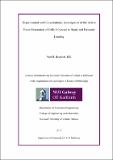| dc.description.abstract | The development of a mechanistic understanding of the processes by which cells sense and actively respond to the mechanical environment would represent a significant advance in the fields of biomechanics and tissue engineering. Investigation at a single cell level is required to obtain new and fundamental insights into this problem. In this thesis a series of experimental tests and cell mechanics models are developed with the aim of advancing the current understanding of cell biomechanics.
Micropipette aspiration (MA) has been used extensively in biomechanical investigations of un-adhered cells suspended in media. However, the MA technique has largely been limited to the investigation of un-adhered cells suspended in media. In the current thesis, a custom MA system is developed to aspirate substrate adhered spread cells. Additionally, the system facilitates immuno-fluorescent imaging of aspirated cells to investigate stress fibre (SF) redistribution and nucleus deformation during MA. In response to an applied pressure, significantly lower aspiration length is observed for untreated contractile cells compared to cells in which actin polymerisation is chemically inhibited, demonstrating the important contribution of SFs in the biomechanical behaviour of spread cells. Additional experiments are performed in which untreated contractile cells are subjected to a range of applied pressures. Computational finite element simulations reveal that a viscoelastic material model for the cell cytoplasm is incapable of accurately predicting the observed aspiration length over the range of applied pressures. It is demonstrated that an active computational framework that incorporates SF remodelling and contractility must be used in order to accurately simulate MA of untreated spread cells. Additionally, the SF distribution observed in immuno-fluorescent experimental images of aspirated cells is accurately predicted using the active SF modelling framework. Finally, a detailed experimental-computational investigation of the nucleus mechanical behaviour demonstrates that the nucleus is highly deformable in cyto, reaching strain levels in excess of 100% during MA.
Previous cell models have assumed that the nucleus is a homogenous material. A new approach to the modelling of the cell nucleus is proposed in this thesis. Greyscale values in confocal z-stacks of nuclear DNA reported in the experimental study of Henderson et al. (Biophys J; 105:2252-61; 2013) are used to determine the local shear modulus at each material point of a finite element mesh of the nucleus. Simulations reveal that the nucleus is highly heterogeneous with local intra-nuclear shear moduli ranging over two orders of magnitude. Predicted maximum shear strains in the nucleus are five times higher than the macroscopic applied shear strain, as observed experimentally. This demonstrates that mechanical heterogeneity of the nucleus results in significant strain magnification, and suggests that nucleus deformation may play a key role in mechanotransduction and cell sensing of the physical environment.
A novel single cell AFM experimental investigation reveals a complex force-strain response of cells to cyclic loading. The biomechanisms underlying such complex behaviour cannot be fully understood without a detailed mechanistic analysis incorporating the key features of active stress generation and remodelling of the actin cytoskeleton. In order to simulate untreated contractile cells, an active bio-chemo-mechanical model is developed, incorporating the key features of SF remodelling and active tension generation. It is demonstrated that a fading memory SF contractility model accurately captures the transient response of cells to dynamic loading. Simulations reveal that high stretching forces during unloading half-cycles (probe retraction) occur due to tension actively generated by axially oriented SFs. On the other hand, hoop oriented SFs generate tension during loading half-cycles, providing a coherent explanation for the elevated compression resistance of contractile cells. Finally, it is also demonstrated that passive non-linear visco-hyperelastic material laws, traditionally used to simulate cell mechanical behaviour, are not appropriate for untreated contractile cells, and their use should be limited to the simulation of cells in which the active force generation machinery of the actin cytoskeleton has been chemically disrupted. In summary, the active modelling framework provides a coherent understanding of the biomechanisms underlying the complex patterns of experimentally observed single cell force generation presented in the experimental component of this investigation.
In previous studies, systems for mechanical testing of engineered tissue constructs have been limited to uniaxial cyclic stretching. In this thesis a novel experimental system is developed for measurement of cell and tissues forces during both uniaxial and biaxial stretching. In the case of uniaxially constrained tissues significant tissue deformation occurs due to cell contractility, and the alignment of cells in the stretching direction results in the measurement of a high actively generated cumulative cell force. In the case of biaxially constrained tissues cells are randomly oriented. This results in a lower actively generated cumulative cell force in each stretching direction. The force measured during biaxial cyclic stretching is only ~1.30 times higher than that measured during uniaxial cyclic stretching. When cells are removed from the tissue biaxial forces are ~1.75 times higher than uniaxial forces. Interpretation of experimental results using an active cell contractility model demonstrates that a uniaxial stress state is necessary to achieve a high degree of cell alignment and, consequently, a high actively generated cumulative cell force in the stretching direction.
The novel experimental-computational approaches to investigate the cell responses to static and dynamic loading provide new insights into the complex biomechanical behaviour of the actin cytoskeleton and the cell nucleus. The findings of this thesis may have important implications for understanding in vivo remodelling of cells and tissues during disease progression, such as atherosclerosis and cardiac hypertrophy. The active cell models developed and implemented in this work can potentially be used to guide tissue engineering strategies to control cell behaviour and gene expression. | en_IE |


